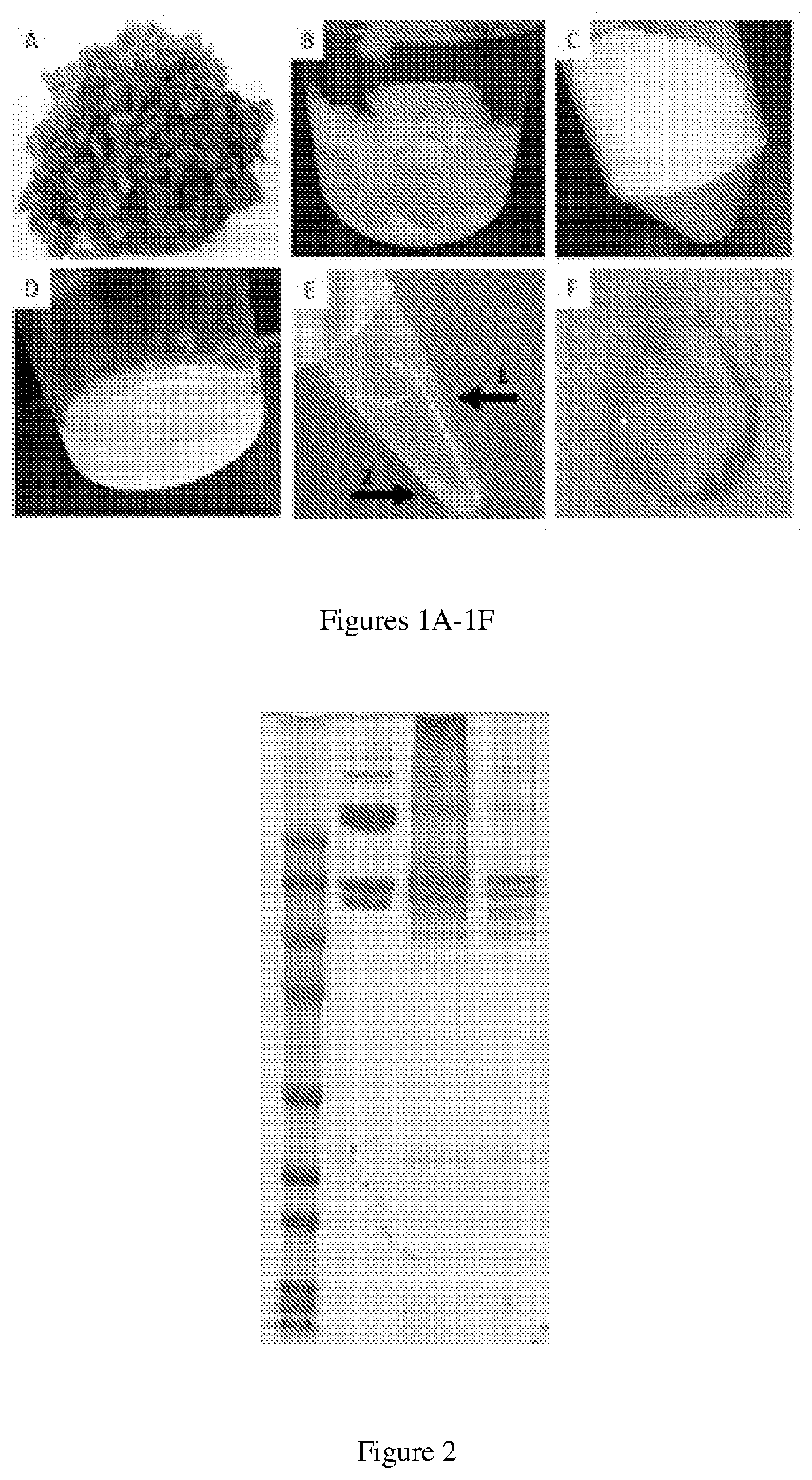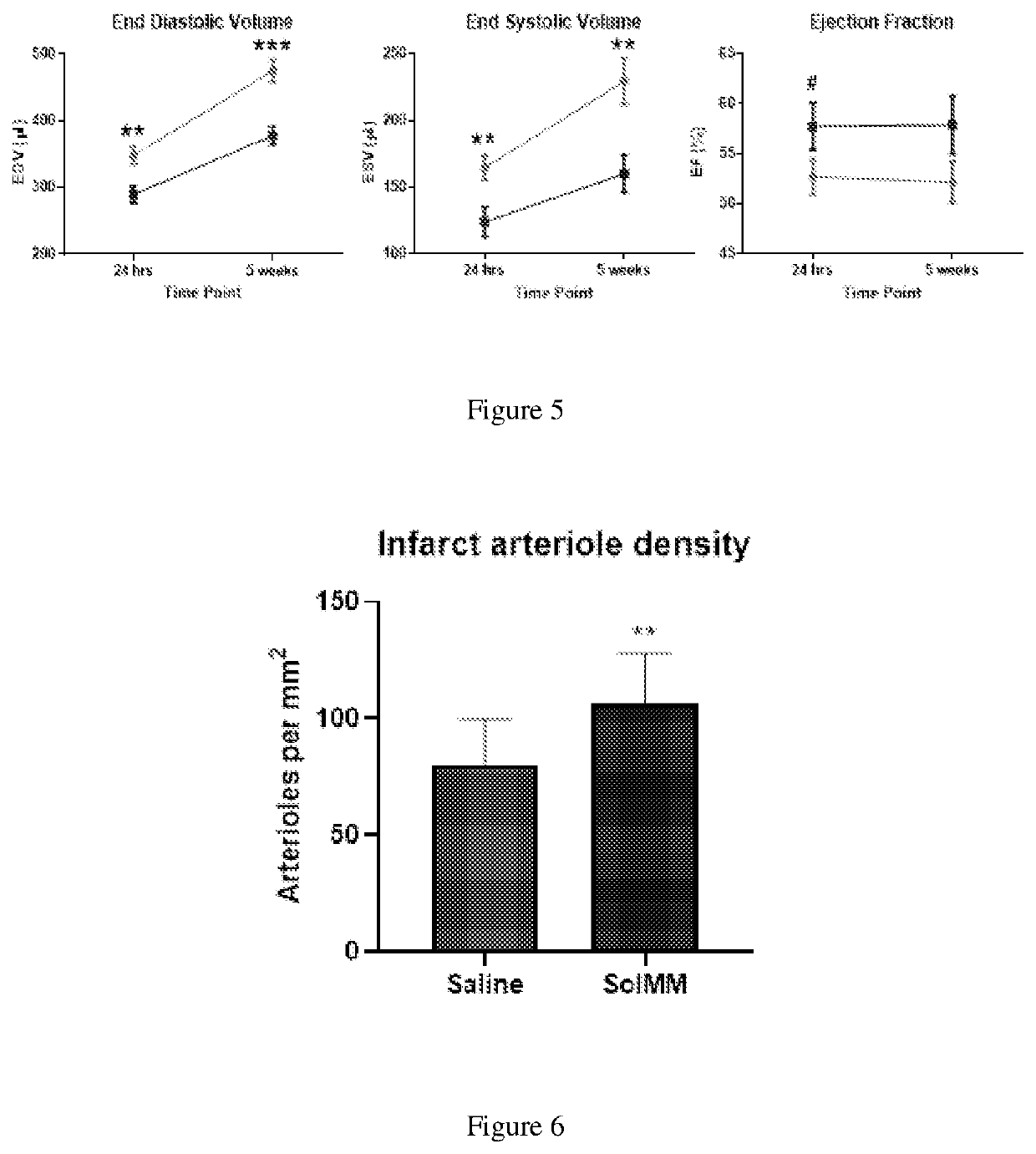Soluble Extracellular Matrix Composition and Method for Intravascular Delivery
a technology of soluble extracellular matrix and composition, which is applied in the direction of drug compositions, peptide/protein ingredients, prosthesis, etc., can solve the problems of inability to fully soluble or transparent colloids, inability to deliver intravascular/infusion-type intravascular/infusion-type therapy, and decellularized hydrogels, etc., to increase viable tissue mass, induce new vascular formation, and increase blood flow
- Summary
- Abstract
- Description
- Claims
- Application Information
AI Technical Summary
Benefits of technology
Problems solved by technology
Method used
Image
Examples
experiment 1
tion and Characterization
[0088]The formulation of myocardial matrix (MM) can be generated based on previously described protocols (FIG. 1) [3]. In brief, fresh hearts are harvested from pigs (approx. 30-45 kg) and the LV myocardium is isolated. Major vessels and connective tissue are removed, and the remaining tissue will be cut into pieces less than 5 mm3 (FIG. 1A). Tissue is decellularized in 1% (w / v) sodium dodecyl sulfate (SDS) for 4-5 days until the tissue is completely white, followed by an additional day of water rinsing to remove residual SDS (FIG. 1B). The material is lyophilized and milled into a fine powder (FIG. 1C) and subsequently partially enzymatically digested for 48 hours. The material is then neutralized and buffered to match in vivo conditions, yielding MM (FIG. 1D), capable of thermally induced gelation.
[0089]Next, the MM is centrifuged at 15,000 RCF at 4° C. to separate the soluble and insoluble fractions (FIG. 1E). The supernatant is isolated from the insolubl...
experiment 2
ility of the SolMM with Human Blood
[0090]The interaction between SolMM and human blood samples (n=4) is assessed at different dilutions (1:1, 1:2, 1:10) of SolMM to whole human blood or platelet rich plasma. 1:1 represents the highest possible ratio between blood and SolMM, whereas 1:10 represents a physiologically relevant dilution based on the volumetric flow rate of the coronary vasculature and intended infusion rate (1 ml / min). Hemocompatibility is assessed as previously described for MM [4]. Red blood cell aggregation will be performed within 4 hours of sampling on a Myrenne aggregonometer (Myrenne GmbH) after adjusting hematocrit to 45% with autologous plasma. Aggregation is assessed following stasis (M0) or a low shear rate (3 Hz; M1) while absorbance (800 nm) is measured for 5 seconds. Similarly, platelet aggregation is measured with isolated platelet rich plasma on a lumi-aggregonometer (Chrono-log). Using the same dilutions as above for sample to platelet rich plasma, high...
experiment 3
, Retention, and Efficacy in a Small Animal Ischemia-Reperfusion Model
[0092]Using a Sprague Dawley rat (225-250 g) ischemia-reperfusion model of MI, the left coronary artery is occluded for 45 minutes, followed by reperfusion. Within 5 minutes following reperfusion, the aorta is clamped for approximately 15 seconds to simulate intracoronary infusion, and 200 μl of SolMM is injected in to the LV lumen at a concentration of 6, 10, or 14 mg / mL. This will force the material into the coronary arteries and then distribute into the infarcted myocardium [12]. Hearts (n=2 per concentration) are isolated 60-minutes post-injection to determine if the material will initially distribute and then be retained in the heart, as non-gelling materials are cleared from the heart within an hour [5]. SolMM is conjugated with Alexa Fluor™ 568 N-hydroxysuccinimidyl ester (Invitrogen) to allow for fluorescent detection and analysis. Retention of the material is tested with the optimal concentration at the t...
PUM
| Property | Measurement | Unit |
|---|---|---|
| size exclusion | aaaaa | aaaaa |
| size | aaaaa | aaaaa |
| size | aaaaa | aaaaa |
Abstract
Description
Claims
Application Information
 Login to View More
Login to View More - R&D
- Intellectual Property
- Life Sciences
- Materials
- Tech Scout
- Unparalleled Data Quality
- Higher Quality Content
- 60% Fewer Hallucinations
Browse by: Latest US Patents, China's latest patents, Technical Efficacy Thesaurus, Application Domain, Technology Topic, Popular Technical Reports.
© 2025 PatSnap. All rights reserved.Legal|Privacy policy|Modern Slavery Act Transparency Statement|Sitemap|About US| Contact US: help@patsnap.com



